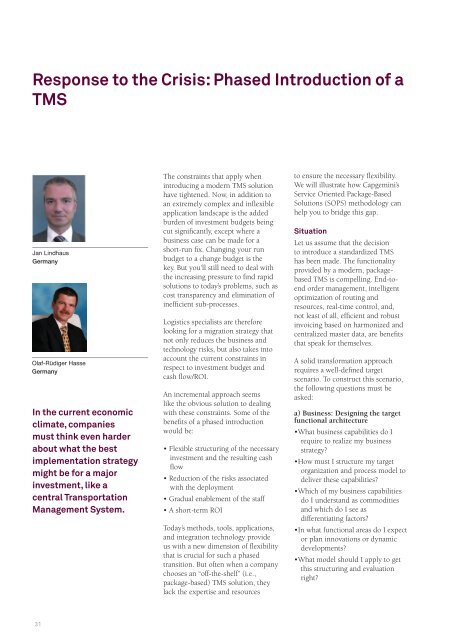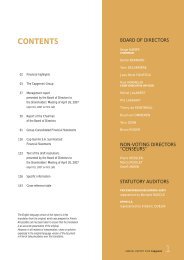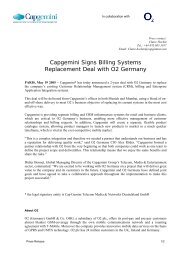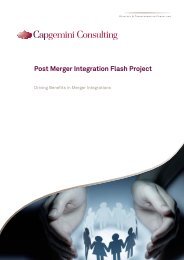Transportation Management Report 2011 - Capgemini
Transportation Management Report 2011 - Capgemini
Transportation Management Report 2011 - Capgemini
Create successful ePaper yourself
Turn your PDF publications into a flip-book with our unique Google optimized e-Paper software.
Response to the Crisis: Phased Introduction of a<br />
TMS<br />
Jan Lindhaus<br />
Germany<br />
Olaf-Rüdiger Hasse<br />
Germany<br />
In the current economic<br />
climate, companies<br />
must think even harder<br />
about what the best<br />
implementation strategy<br />
might be for a major<br />
investment, like a<br />
central <strong>Transportation</strong><br />
<strong>Management</strong> System.<br />
31<br />
The constraints that apply when<br />
introducing a modern TMS solution<br />
have tightened. Now, in addition to<br />
an extremely complex and inflexible<br />
application landscape is the added<br />
burden of investment budgets being<br />
cut significantly, except where a<br />
business case can be made for a<br />
short-run fix. Changing your run<br />
budget to a change budget is the<br />
key. But you’ll still need to deal with<br />
the increasing pressure to find rapid<br />
solutions to today’s problems, such as<br />
cost transparency and elimination of<br />
inefficient sub-processes.<br />
Logistics specialists are therefore<br />
looking for a migration strategy that<br />
not only reduces the business and<br />
technology risks, but also takes into<br />
account the current constraints in<br />
respect to investment budget and<br />
cash flow/ROI.<br />
An incremental approach seems<br />
like the obvious solution to dealing<br />
with these constraints. Some of the<br />
benefits of a phased introduction<br />
would be:<br />
• Flexible structuring of the necessary<br />
investment and the resulting cash<br />
flow<br />
• Reduction of the risks associated<br />
with the deployment<br />
• Gradual enablement of the staff<br />
• A short-term ROI<br />
Today’s methods, tools, applications,<br />
and integration technology provide<br />
us with a new dimension of flexibility<br />
that is crucial for such a phased<br />
transition. But often when a company<br />
chooses an “off-the-shelf” (i.e.,<br />
package-based) TMS solution, they<br />
lack the expertise and resources<br />
to ensure the necessary flexibility.<br />
We will illustrate how <strong>Capgemini</strong>’s<br />
Service Oriented Package-Based<br />
Solutions (SOPS) methodology can<br />
help you to bridge this gap.<br />
Situation<br />
Let us assume that the decision<br />
to introduce a standardized TMS<br />
has been made. The functionality<br />
provided by a modern, packagebased<br />
TMS is compelling. End-toend<br />
order management, intelligent<br />
optimization of routing and<br />
resources, real-time control, and,<br />
not least of all, efficient and robust<br />
invoicing based on harmonized and<br />
centralized master data, are benefits<br />
that speak for themselves.<br />
A solid transformation approach<br />
requires a well-defined target<br />
scenario. To construct this scenario,<br />
the following questions must be<br />
asked:<br />
a) Business: Designing the target<br />
functional architecture<br />
•What business capabilities do I<br />
require to realize my business<br />
strategy?<br />
•How must I structure my target<br />
organization and process model to<br />
deliver these capabilities?<br />
•Which of my business capabilities<br />
do I understand as commodities<br />
and which do I see as<br />
differentiating factors?<br />
•In what functional areas do I expect<br />
or plan innovations or dynamic<br />
developments?<br />
•What model should I apply to get<br />
this structuring and evaluation<br />
right?















